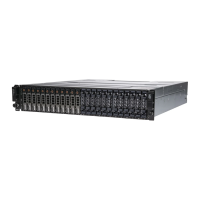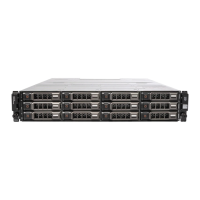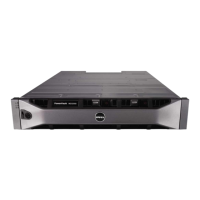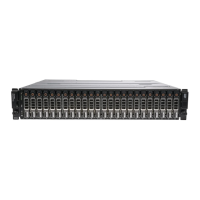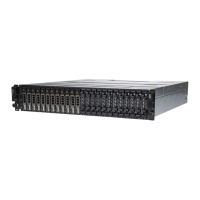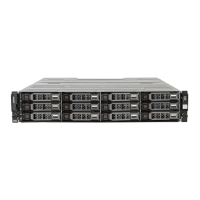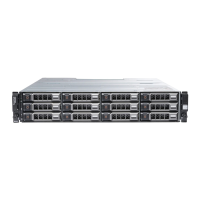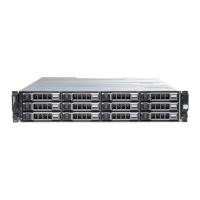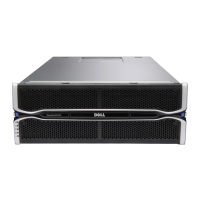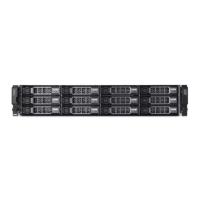





Do you have a question about the Dell PowerVault MD3200 and is the answer not in the manual?
Provides an overview of the manual's structure and content organization.
Lists the components included in the product package for the storage array.
Describes the design and core components of the MD3200 Series storage array.
Details the physical components and indicators on the front and back panels.
Explains the function and features of RAID controller modules for high-performance storage.
Identifies and describes the connectors and LEDs on the RAID controller module.
Explains cache mirroring, write-back, and write-through cache operations.
Defines fundamental storage concepts: physical disks, disk groups, and virtual disks.
Explains different RAID levels and their impact on performance and redundancy.
Details processes like initialization, consistency checks, and media verification.
Describes the layout and components of the Storage Manager interface.
Explains the EMW's role in high-level management and discovering arrays.
Details the AMW's functions for managing individual storage arrays.
Explains the two methods for managing the storage array remotely.
Guides through initial tasks like naming, password setting, and basic configuration.
Describes how to set up e-mail and SNMP alerts for array events.
Explains how to activate or deactivate the event monitoring service on Windows and Linux.
Details how to define and manage host access to storage array virtual disks.
Explains how to define host-to-virtual disk mappings and manage topology.
Covers creating, moving, and removing host groups for clustered environments.
Guides on organizing physical disks into groups and creating virtual disks.
Explains how to enable and manage security features for self-encrypting disks.
Details how to assign and manage hot spare disks for fault tolerance.
Explains how to map virtual disks to hosts or host groups for access.
Describes how to define logical partitions for host or host group access.
Covers creating immediate or scheduled snapshots for data backup and recovery.
Provides a simplified method for creating snapshots with default parameters.
Offers advanced options for placing and configuring snapshot repository virtual disks.
Explains how to revert a virtual disk to a previous snapshot state.
Differentiates between offline and online virtual disk copying methods.
Details the process of creating virtual disk copies for Microsoft Cluster Server.
Lists limitations and rules applicable to virtual disk copy operations.
Guides through the steps to initiate a virtual disk copy operation.
Describes how to halt an ongoing virtual disk copy operation.
Covers enabling the premium feature to enhance system performance.
Introduces Device Mapper (DM) for multipathing capabilities on Linux.
Provides step-by-step instructions for configuring DM multipathing.
Lists known limitations and potential issues with DM multipathing.
Details the process of downloading firmware updates for physical disks.
Explains how to update firmware for expansion module EMMs.
Describes SMART's role in monitoring disk health and predicting failures.
Lists essential tools required for installing array components.
Covers the removal and installation procedure for the front bezel.
Details safety precautions and procedures for handling hard drives.
Explains how to safely remove a hard drive from the system.
Provides instructions for installing a new hard drive into the array.
Covers installation requirements and handling of RAID controller modules.
Details the steps for safely removing a RAID controller module.
Provides instructions for installing a new RAID controller module.
Explains the removal and installation of power supply and cooling fan modules.
Covers the removal and installation procedures for the control panel assembly.
Details the steps for removing and installing the backplane.
Describes how to view and save firmware information for array components.
Explains the role of Microsoft Virtual Disk Service (VDS) and VSS Provider.
Guides on checking indicators and sounds during the array's startup process.
Explains how to interpret status icons (Optimal, Needs Attention, etc.) in MDSM.
Details how to collect and save diagnostic data for troubleshooting.
Provides essential safety precautions for working with the storage array.
Offers checks for issues that occur during the array's startup.
Covers procedures for diagnosing and resolving power supply or fan module problems.
Addresses issues related to Expansion Enclosure Management Modules (EMMs).
Provides guidance for diagnosing and resolving problems with RAID controller modules.
Offers steps to diagnose and resolve issues related to physical hard drives.
Guides on verifying and resolving issues with physical cable connections.
Provides procedures for handling a storage array exposed to liquid.
Covers general steps for diagnosing issues with a physically damaged array.
Provides information on how to contact Dell support for assistance.
| HDD speed | 15000 RPM |
|---|---|
| RAID levels | 0, 1, 5, 6, 10 |
| Storage drive size | 3.5 \ |
| Storage drive capacity | 300 GB |
| Storage drive interface | Serial Attached SCSI (SAS) |
| Storage drives installed | Yes |
| Installed storage drive type | HDD |
| Supported storage drive types | HDD & SSD |
| Total installed storage capacity | 0.6 TB |
| Maximum supported storage capacity | - TB |
| Number of storage drives installed | 2 |
| Number of storage drives supported | 12 |
| Host ports | 4 |
| RJ-45 ports quantity | 1 |
| Chassis type | - |
| Product color | Black |
| AC input voltage | 90-264 V |
| AC input frequency | 47/63 Hz |
| Power supply unit (PSU) capacity | 600 W |
| Operating altitude | -15 - 3048 m |
| Storage temperature (T-T) | 5 - 40 °C |
| Operating temperature (T-T) | 10 - 35 °C |
| Storage relative humidity (H-H) | 5 - 85 % |
| Operating relative humidity (H-H) | 10 - 80 % |
| Depth | 561 mm |
|---|---|
| Width | 446.3 mm |
| Height | 86.8 mm |
| Weight | 29300 g |
